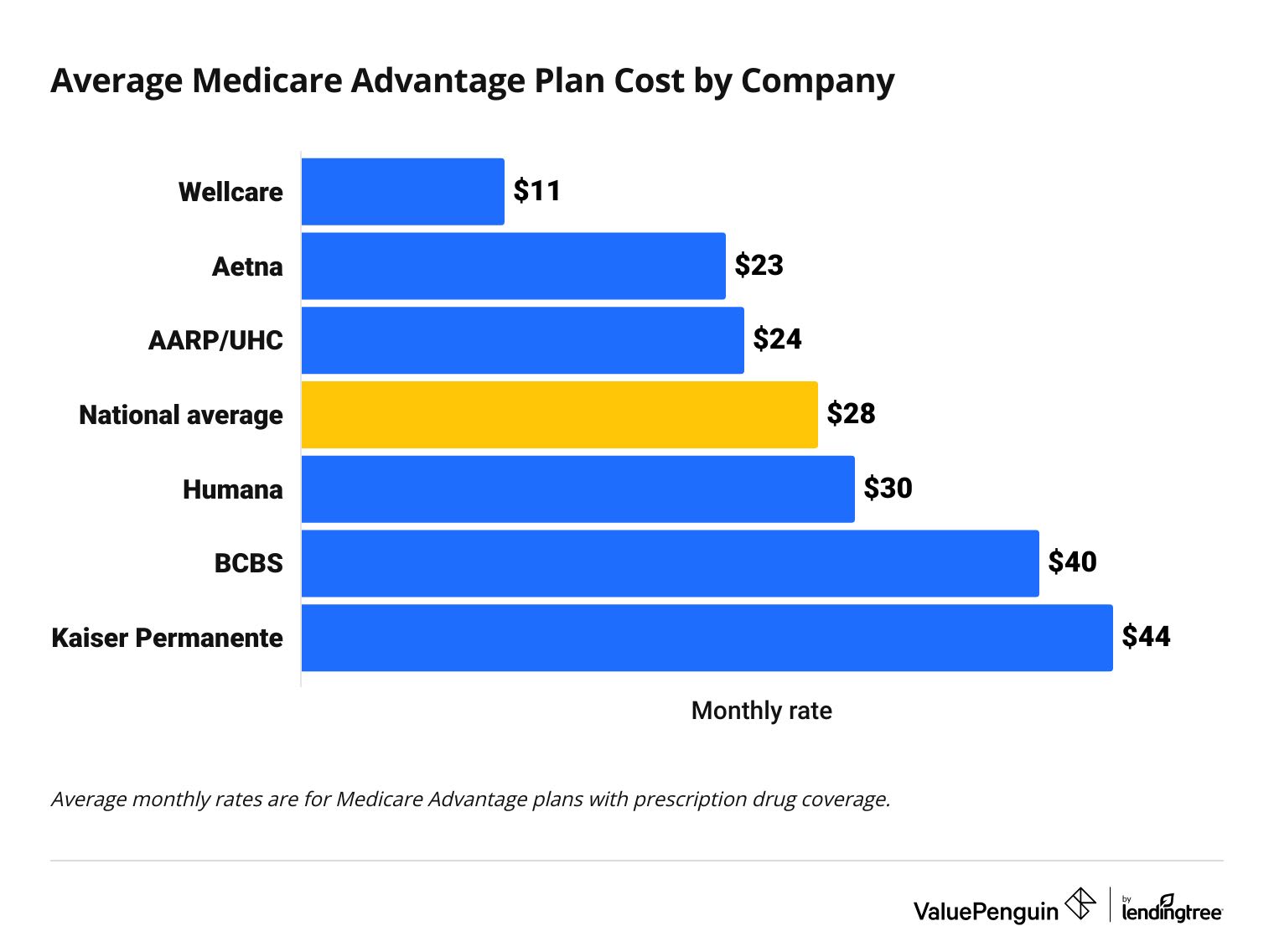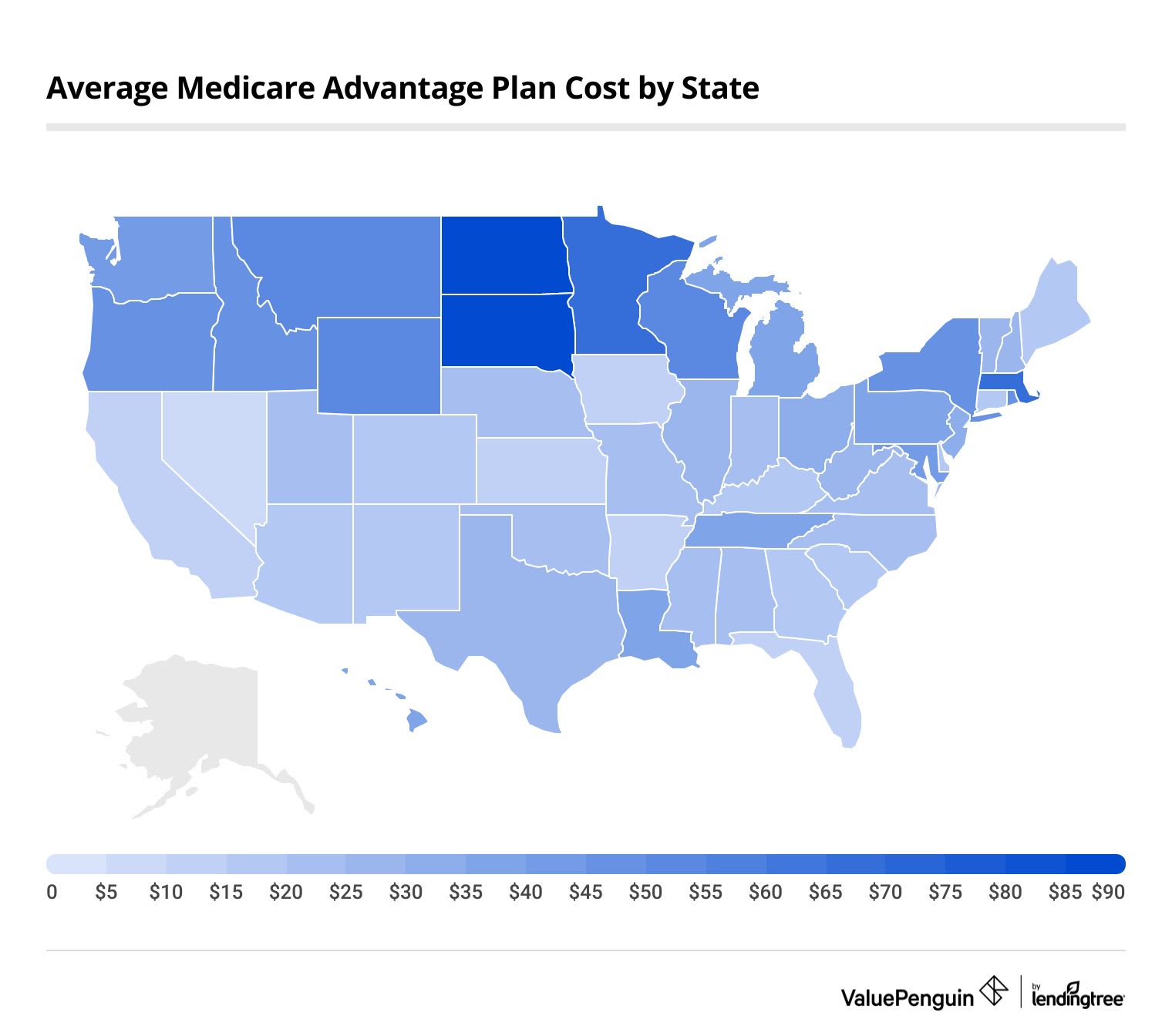What's the Cost of a Medicare Advantage Plan?
Compare Medicare Plans in Your Area
A Medicare Advantage plan with prescription drug coverage costs $28 per month, on average.
More than half of all plans have no monthly cost. The amount you pay for a Medicare Advantage plan depends on factors like the amount of coverage you get and the ability to see doctors outside your network.
How much do Medicare Advantage plans cost?
Medicare Advantage plans with prescription drug coverage cost an average of $28 per month in 2025, up from $27 in 2024.
The amount you pay for a Medicare Advantage plan depends in large part on the type of plan you buy. More restrictive plans like
HMOs
tend to cost less than plans that give you more freedom like
PPOs.

It's important to remember that many Medicare Advantage plans cost $0 per month. You'll still have to cover some costs when you go to the doctor with these plans. For example, Medicare Advantage plans typically require you to pay a certain amount of money before coverage starts, called a deductible.
Many Medicare Advantage plans have a separate deductible for prescription drugs. The average drug deductible for 2025 Medicare Advantage plans is $316.
Average monthly cost by Medicare Advantage plan type
With a Medicare Advantage plan, you're also responsible for paying a part of your bill when you go to the hospital. These costs include:
- Copays: A flat fee you pay when you get care or fill a prescription. For example, you may pay a $20 copay when you see the doctor for your annual checkup.
- Coinsurance: A percentage of your bill that you pay. For example, 20% coinsurance on a procedure that costs $500 would cost you $100.
Copays and coinsurance amounts will be different depending on your plan. Policies with higher monthly rates usually make you pay less when you see the doctor.
In addition, all plans cap the amount you'll pay for care in a single year, called an out-of-pocket maximum. For 2025, the average Medicare Advantage out-of-pocket max is $5,915 for in-network care.
Medicare Advantage plan cost by company
Wellcare has the cheapest average rates of any major Medicare Advantage company, at $11 per month.
Aetna and AARP/UnitedHealthcare both have affordable plans, at $23 and $24 per month, on average, respectively. All the largest Medicare Advantage companies offer plans with no monthly cost.

Compare Medicare Plans in Your Area
When shopping around, it's important to consider factors other than price. For example, Blue Cross Blue Shield (BCBS) has high average rates, but BCBS customers get access to the largest network of doctors in the country. It might make sense to pay more for a Blue Cross plan if you want more freedom in choosing your doctor.
Kaiser Permanente has the most expensive average rates and the fewest number of $0 plans among major Medicare Advantage companies. However, Kaiser has a strong reputation for customer satisfaction. Consider a Medicare Advantage plan from Kaiser Permanente if you value a smooth claim filing process over getting the cheapest rate.
Monthly Medicare Advantage cost by company
Company | Average monthly cost | |
|---|---|---|
| Wellcare | $11 | |
| Aetna/CVS | $23 | |
| AARP/UnitedHealthcare | $24 | |
| Humana | $30 | |
| Blue Cross Blue Shield | $40 |
Cigna has cheap Medicare Advantage plans, at $6 per month on average. You can buy Cigna Medicare Advantage plans during the 2025 open enrollment period.
However, Cigna is selling its Medicare Advantage business to Health Care Service Corp. (HCSC), a Blue Cross Blue Shield company. That means your Cigna Medicare Advantage plan will become a Blue Cross plan later in 2025.
Average cost by state
The average cost of a Medicare Advantage plan depends on where you live.
In the most expensive state for Medicare Advantage, South Dakota, coverage costs $93 per month on average. That's almost 16 times higher than the Nevada average of $6 per month.

Medicare Advantage plans aren't available in Alaska.
Zero-dollar plans are available in every state (except Alaska). Even if you live in a state with a high average rate, you probably still have access to low-cost Medicare Advantage plans.
Factors like the number and type of plans available, the cost of care and the companies selling plans can all influence the average cost of a Medicare Advantage plan in your state.
Medicare Advantage cost by state
Compare Medicare Plans in Your Area
How to get the best deal with a Medicare Advantage plan
How you can save
What to avoid if you want to save money
Total monthly Medicare Advantage costs
Even when you sign up for Medicare Advantage, you'll still have to pay for Original Medicare (Parts A and B).
A Medicare Advantage plan is sold by a private insurance company, but it’s part of the government’s Medicare program. So while the cost of Medicare Advantage is determined by the plan you choose, the costs for Medicare Parts A and B are set by the government.
Typical monthly costs:
-
Medicare Part A (hospitalization): $0
About 99% of Medicare enrollees don't pay anything for Medicare Part A. That's because your taxes pay for this program. While you (or your spouse) were working, you paid a Medicare tax on your income, and as a result, you won't pay for Medicare Part A when you're retired.
-
Medicare Part B (medical care): $185 per month in 2025
The government sets the cost of Medicare Part B each year. Most people pay this monthly cost directly from their Social Security benefits. The government charges an extra fee, called IRMAA, if you earn more than $106,000 per year.
-
Medicare Advantage (bundled coverage): $28 per month, on average, in 2025
What you pay for a Medicare Advantage plan covers some of the plan's extra benefits, such as vision, dental and prescription drug benefits. Keep in mind that the government also gives companies extra money to spend on these benefits. That enables companies to offer plans with no monthly rates. There are also some plans that have a "giveback" program. The plans cost $0 per month and reduce your monthly cost for Medicare Part B.
How much does the government pay for Medicare Advantage plans?
What you pay for a Medicare Advantage plan only represents part of the plan's cost. Medicare also pays insurance companies a flat rate for each Medicare enrollee, typically more than $1,000 per month. The actual payment amount depends on location, plan benefits and overall community health.
Frequently asked questions
How much is Medicare Part C?
Medicare Advantage plans cost $28 per month on average. How much you pay will depend on factors like your plan type, the company you choose and where you live.
How does Medicare Advantage work?
Medicare Advantage bundles your regular Medicare (Parts A and B) coverage with extra benefits like prescription drugs, vision, dental and wellness programs. Private companies sell and run Medicare Advantage plans. However, you're still responsible for paying your Medicare Part B monthly rate to the government regardless of whether you have Original Medicare or a Medicare Advantage plan.
What is the biggest disadvantage of Medicare Advantage?
Medicare Advantage plans typically limit you to a network of doctors. In contrast, Original Medicare lets you see any doctor in the U.S. who accepts Medicare. That makes Original Medicare a better choice if you travel often or want a variety of options.
Methodology and sources
Medicare Advantage costs came from Centers for Medicare & Medicaid Services (CMS) public use files.
Average rates are for plans that include prescription drug coverage. Average rates don't include employer-sponsored plans, special needs plans, Medicare-Medicaid plans (MMPs), Program of All-Inclusive Care for the Elderly (PACE) plans, sanctioned plans and health care prepayment plans (HCPPs).
ValuePenguin.com is owned and operated by LendingTree, LLC ("LendingTree"). All rights reserved.
Invitations for application for insurance may be made through QW Insurance Solutions, LLC ("QWIS"), a separate subsidiary of QuoteWizard, LLC ("QuoteWizard"), a LendingTree subsidiary, or through its designated agents, only where licensed and appointed. QWIS is a non-government licensed health insurance agency and is not affiliated with or endorsed by any government agency. Find licensing information for QWIS.
Callers will be directed to a licensed and certified representative of Medicare Supplement insurance and/or Medicare Advantage HMO, HMO SNP, PPO, PPO SNP and PFFS organizations. Calls will be routed to a licensed insurance agent who can provide you with further information about the insurance plans offered by one or more nationally recognized insurance companies. Each of the organizations they represent has a Medicare contract. Enrollment in any plan depends on contract renewal.
Availability of benefits and plans varies by carrier and location and may be limited to certain times of the year, unless you qualify for a Special Enrollment Period. We do not offer every plan available in your area. Currently we represent 73 organizations that offer 5,110 products in your area. Contact Medicare.gov or 1-800-MEDICARE, or your local State Health Insurance Program (SHIP), to get information on all of your options.
These numbers provided are not specific to your area, but rather represent the number of organizations and the number of products available on a national basis. We will connect you with licensed insurance agents who can provide information about the number of organizations they represent and the number of products they offer in your service area. Not all plans offer all of these benefits. Benefits may vary by carrier and location. Limitations and exclusions may apply.
Medicare has neither reviewed nor endorsed the information contained on this website.
Medicare supplement insurance is available to people age 65 or older enrolled in Medicare Parts A and B, and in some states to those under age 65 eligible for Medicare due to disability or end stage renal disease.
Medicare Advantage and Part D plans and benefits are offered by these carriers: Aetna Medicare, Anthem Blue Cross Blue Shield, Anthem Blue Cross, Aspire Health Plan, Cigna Healthcare, Dean Health Plan, Devoted Health, Florida Blue Medicare, GlobalHealth, Health Care Service Corporation, Healthy Blue, Humana, Molina Healthcare, Mutual of Omaha, Premera Blue Cross, Medica Central Health Plan, SCAN Health Plan, Baylor Scott & White Health Plan, Simply, UnitedHealthcare, Wellcare and WellPoint.
MULTIPLAN_QW.VP.WEB_C
Editorial Note: We are committed to providing accurate content that helps you make informed financial decisions. Our partners have not endorsed or commissioned this content.






